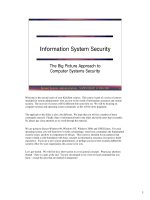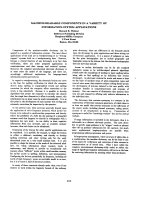Information system ralph CH07
Bạn đang xem bản rút gọn của tài liệu. Xem và tải ngay bản đầy đủ của tài liệu tại đây (322.54 KB, 48 trang )
Fundamentals of Information
Systems, Fifth Edition
Chapter 7
Knowledge Management and
Specialized Information Systems
Principles and Learning Objectives
• Knowledge management allows organizations to
share knowledge and experience among their
managers and employees
– Discuss the differences among data, information,
and knowledge
– Describe the role of the chief knowledge officer
(CKO)
– List some of the tools and techniques used in
knowledge management
Fundamentals of Information Systems, Fifth Edition
2
Principles and Learning Objectives
(continued)
• Artificial intelligence systems form a broad and diverse
set of systems that can replicate human decision
making for certain types of well-defined problems
– Define the term artificial intelligence and state the
objective of developing artificial intelligence systems
– List the characteristics of intelligent behavior and
compare the performance of natural and artificial
intelligence systems for each of these characteristics
– Identify the major components of the artificial
intelligence field and provide one example of each type
of system
Fundamentals of Information Systems, Fifth Edition
3
Principles and Learning Objectives
(continued)
• Expert systems can enable a novice to perform at
the level of an expert but must be developed and
maintained very carefully
– List the characteristics and basic components of
expert systems
– Identify at least three factors to consider in
evaluating the development of an expert system
– Outline and briefly explain the steps for developing
an expert system
– Identify the benefits associated with the use of
expert systems
Fundamentals of Information Systems, Fifth Edition
4
Principles and Learning Objectives
(continued)
• Virtual reality systems can reshape the interface
between people and information technology by
offering new ways to communicate information,
visualize processes, and express ideas creatively
– Define the term virtual reality and provide three
examples of virtual reality applications
Fundamentals of Information Systems, Fifth Edition
5
Principles and Learning Objectives
(continued)
• Specialized systems can help organizations and
individuals achieve their goals
– Discuss examples of specialized systems for
organizational and individual use
Fundamentals of Information Systems, Fifth Edition
6
Knowledge Management Systems
• Data consists of raw facts
• Information is a collection of facts
• Knowledge
– Awareness and understanding of a set of information
and the ways that information can be made useful
• Knowledge management system (KMS)
– Organized collection of people, procedures,
software, databases, and devices
Fundamentals of Information Systems, Fifth Edition
7
Overview of Knowledge Management
Systems
• Explicit knowledge
– Objective
– Can be measured and documented in reports,
papers, and rules
• Tacit knowledge
– Hard to measure and document
– Typically not objective or formalized
Fundamentals of Information Systems, Fifth Edition
8
Data and Knowledge Management
Workers and Communities of Practice
• Personnel involved in a KMS
– Data workers: secretaries, administrative
assistants, bookkeepers, other data-entry personnel
– Knowledge workers: people who create, use, and
disseminate knowledge
• Communities of practice (COP)
– Used to create, store, and share knowledge
Fundamentals of Information Systems, Fifth Edition
9
Obtaining, Storing, Sharing, and Using
Knowledge
• Knowledge repository
– Stores knowledge including documents, reports,
files, and databases
• Knowledge workers
– Use collaborative work software and group support
systems to share knowledge
• Knowledge map
– Points knowledge worker to the needed knowledge
Fundamentals of Information Systems, Fifth Edition
10
Fundamentals of Information Systems, Fifth Edition
11
Technology to Support Knowledge
Management
• Tools for capturing and using knowledge
– Data mining and business intelligence
– Enterprise resource planning tools, such as SAP
– Groupware
• Examples of specific KM products
– IBM’s Lotus Notes, Domino
– Microsoft’s Digital Dashboard, Web Store
Technology, Access Workflow Designer
Fundamentals of Information Systems, Fifth Edition
12
An Overview of Artificial Intelligence
• Artificial intelligence (AI)
– Computers with the ability to mimic or duplicate the
functions of the human brain
Fundamentals of Information Systems, Fifth Edition
13
Artificial Intelligence in Perspective
• Artificial intelligence systems
– People, procedures, hardware, software, data, and
knowledge needed to develop computer systems
and machines that demonstrate characteristics of
intelligence
Fundamentals of Information Systems, Fifth Edition
14
The Nature of Intelligence
• Characteristics of intelligent behavior include the
ability to:
– Learn from experience and apply knowledge
acquired from experience
– Handle complex situations
– Solve problems when important information is
missing
– Determine what is important
– React quickly and correctly to a new situation
Fundamentals of Information Systems, Fifth Edition
15
The Difference Between Natural and
Artificial Intelligence
• Experts have disagreed about the difference
between natural and artificial intelligence
• Creating machines that can reason
– Possible only when we truly understand our own
processes for doing so
Fundamentals of Information Systems, Fifth Edition
16
Fundamentals of Information Systems, Fifth Edition
17
The Major Branches of Artificial
Intelligence
• AI is a broad field that includes several specialty
areas, such as:
–
–
–
–
–
–
Expert systems
Robotics
Vision systems
Natural language processing
Learning systems
Neural networks
Fundamentals of Information Systems, Fifth Edition
18
Fundamentals of Information Systems, Fifth Edition
19
Expert Systems
• Hardware and software that stores knowledge and
makes inferences, similar to a human expert
Fundamentals of Information Systems, Fifth Edition
20
Robotics
• Mechanical or computer devices that perform tasks
requiring a high degree of precision
• Contemporary robotics
– Combines high-precision machine capabilities with
sophisticated controlling software
• Future robots
– Will find wider applications in banks, restaurants,
homes, doctors’ offices, and hazardous working
environments
Fundamentals of Information Systems, Fifth Edition
21
Vision Systems
• Hardware and software that permit computers to
capture, store, and manipulate visual images and
pictures
• Used by the U.S. Justice Department to perform
fingerprint analysis
• Can be used in identifying people based on facial
features
Fundamentals of Information Systems, Fifth Edition
22
Natural Language Processing and
Voice Recognition
• Natural language processing
– Allows the computer to understand and react to
statements and commands made in a “natural”
language, such as English
• Voice recognition
– Converting sound waves into words
Fundamentals of Information Systems, Fifth Edition
23
Learning Systems
• Combination of software and hardware that:
– Allows the computer to change how it functions or
reacts to situations based on feedback it receives
• Learning systems software
– Requires feedback on the results of actions or
decisions
Fundamentals of Information Systems, Fifth Edition
24
Neural Networks
• Can simulate the functioning of a human brain
• Can process many pieces of data at the same time
and learn to recognize patterns
• Particular skill of neural nets
– Analyzing detailed trends
Fundamentals of Information Systems, Fifth Edition
25









